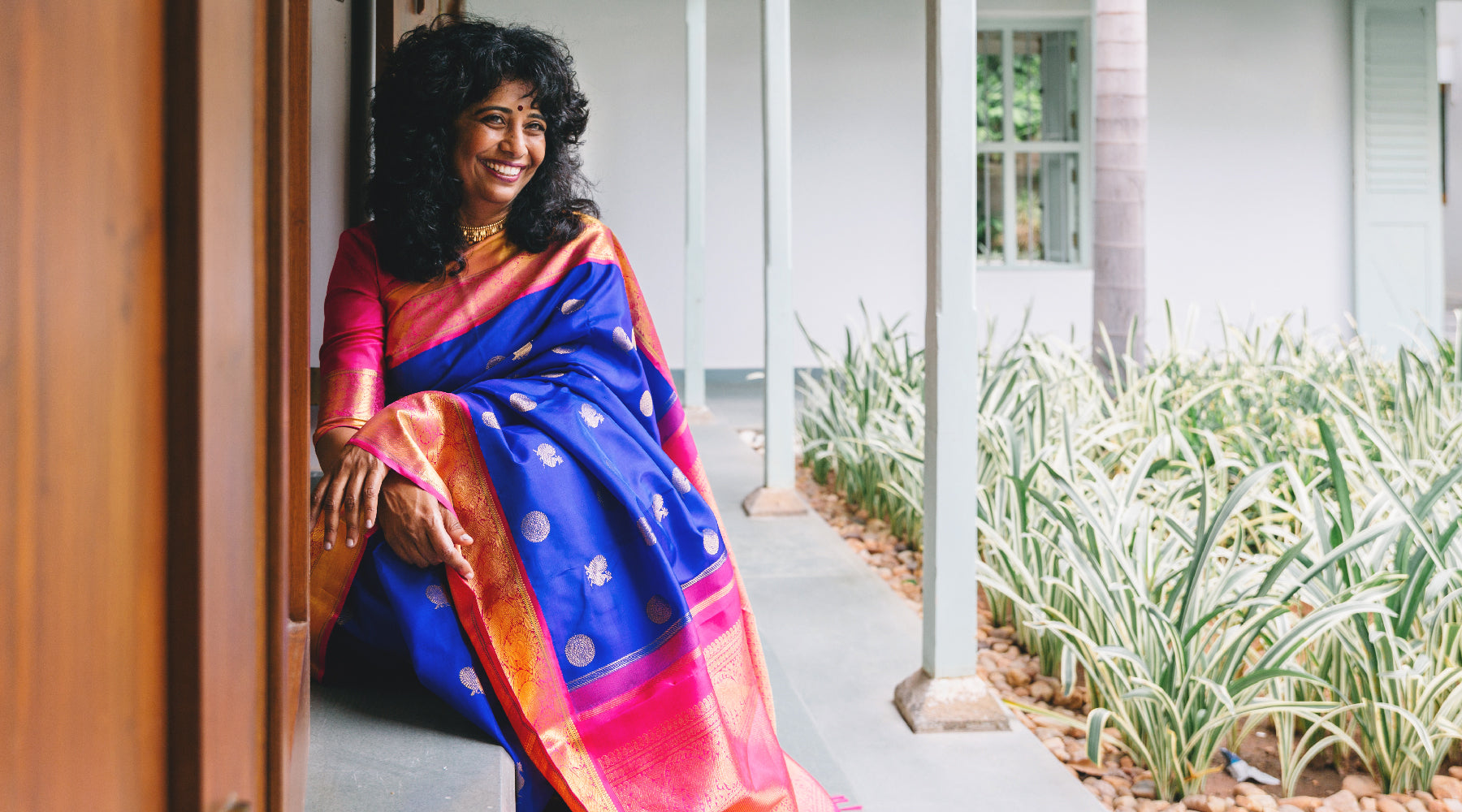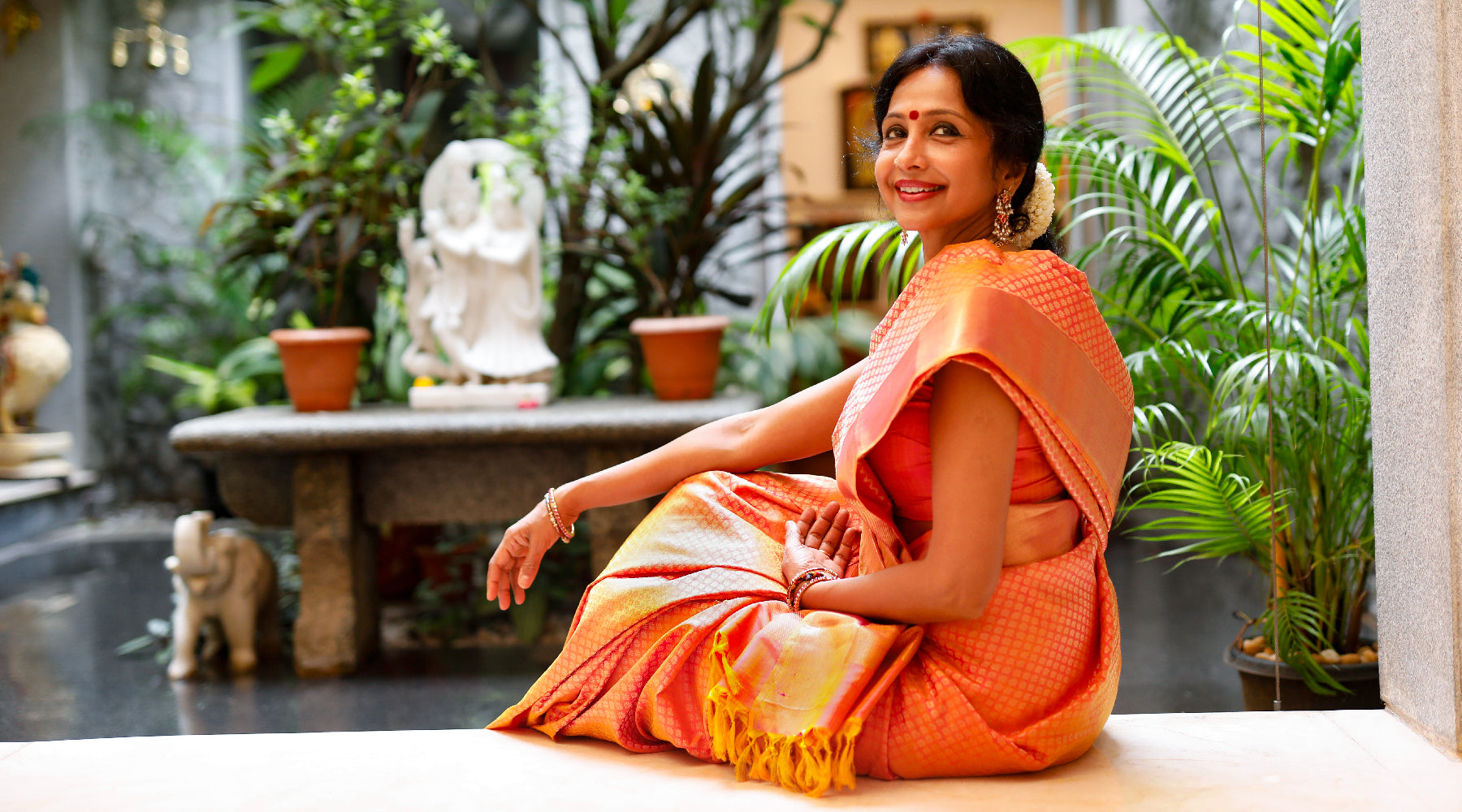KANAKAVALLI VIGNETTES : KH Kanna - A Dance To Remember

Kieran Heralall, better known as KH Kanna, is a Bharatanatyam dancer based in Toronto, Canada, and Kanakavalli’s October Vignette. Despite having a full-time day job as an insurance professional, Kanna performs around the world, choreographs his own shows, and studies Carnatic vocal music, inspired by his love for the classical arts. In a candid conversation with Aneesha Bangera of the Kanakavalli Journal, he opens up about having to make sacrifices to pursue his passions, and about what dance means to him.
With the festive season upon us, Kanna pauses to reminisce about the significance of Navaratri and Diwali in his own life, and how this has changed over the years. Kanna tells us how he stumbled upon Kanakavalli while searching for the perfect mukkuthi (nosepin), how he loves the versatility and grace of the kanjivaram’s drape, and how he believes beauty is all about perception. Browsing through the www.kanakavalli.com repertoire, Kanna curates a selection of kanjivarams that is testament to his love for tradition and beauty. Excerpts from the conversation below…
A Dance to Remember
How did you first begin your journey into the world Bharatanatyam dance? Tell us about how you discovered a love for movement, and how you came to be known as Kanna.
I grew up in Vancouver, Canada, in a family that was not very well acquainted with the classical arts. My love for Indian music was piqued and nurtured through Bollywood films, the easiest available medium to experience it at the time. Seeing this, my elder sister suggested I take up classical dance, which led me to Bharatanatyam, and later Carnatic vocal music. I spent my days rather untroubled by ideas of where this path would lead me. I just went through my routine of school, class and rehearsals, performances, and regular extra-curricular activities with my childhood friends. Dance always came to the forefront of my priorities, however. It has always provided me with an outlet and a freeness that I cannot find in anything else. The name Kanna was given to me by my guru. She just sort of started calling me that rather than my given name and introducing me as such. So, I affixed my initials ahead of it as my stage name “KH Kanna”, as a tribute to my guru.

Kanna with his vocal Guru Sri Arun Gopinath, left and right, Kanna as a child - "I was always a poser," he says.
Is dance what you do for a living? If not, tell us a bit about your day job and how you balance your work and your passions.
I do dance as full time as possible along with my full-time job as an insurance professional. There is a lot of sacrificing to be done when one wants to pursue a passion alongside a full time ‘traditional’ career, be it sleep, time with loved ones, or other priorities that get neglected. I always make sure to schedule my life so that neither work nor dance overlap or interfere with the other. It isn’t difficult to do but it does exhaust the mind and the body quite a bit. The reward, however, is that it keeps me happy.
Do choreography and performance in Bharatanatyam mean different things to you? Tell us a little bit about the challenges and joys of both these roles.
I think I view performance and choreography differently; I believe it comes down to the title an artist chooses to take. A choreographer need not necessarily ever perform. There was a time when dancers who enjoyed a successful career as performers would eventually turn just to teaching and choreography. These days it goes hand in hand for many performers, especially when making a living is dependent on it. If a performer chooses to depend on teaching to earn an income, most times the challenge lies in how to continuously engage students who are advancing in their training, or even to set themselves apart as a unique teacher from others. They may have to challenge themselves to choreograph new material to keep building their students’ capabilities as well as their own as an artiste. Luckily for me I get to enjoy and explore both aspects a little more lightly as I currently don’t teach at all. I’m enjoying getting opportunities to perform as well as just starting to experiment and create choreography with many talented co-artistes.

Kanna in performance, photographed by S. Sivaruban
How does your training in classical Bharatanatyam help you as you practice other forms of dance and movement?
Bharatanatyam has helped develop a very strong core within me. For many years I danced many other forms, mainly dancehall, hip-hop, salsa, and various folk dances. There is an acute awareness of the body and its capabilities after years of the intense adavu training provided by the form. I personally find that classically trained dancers tend to be able to adapt to other styles easily, but not for lack of hard work and concentration, of course. No style of dance is easy to grasp initially.
What role does Carnatic vocal music play in your life and work?
Actually, it is almost all I listen to now – partly because I do learn vocal music as an additional subject in my dance education, but also just because of how rich it is in its intricacies and shades. There is so much to explore and experience by continuous exposure. Many of my closest friends are Carnatic musicians and they have all influenced my work quite a lot. One of the most fulfilling parts of what I do is the opportunity to collaborate and create with people who have such immense knowledge in music.
What are some of your most cherished memories related to dance?
One of my first experiences in a professional production brought me to Patna, on the banks of the Ganga during Shivratri with the Janak Khendry Dance Company. In the production, I was portraying the role of Shiva. So, to perform on Shivratri after doing a Shiva pooja at the holiest river was a really transcendent experience. Another memorable moment was receiving a phone call from Padmashri Leela Samson to perform with her dance company Spanda for two performances of their latest production. The most recent would be the undertaking of two large productions where all my co-artistes were young semi-professionals. Developing these projects from the ground up and committing them from the mind to the stage is an experience from which I learnt so much and one that I will carry with me forever. But overall, all the classes I spend with my gurus Smt. Malini Pararajasingham and Sri. Arun Gopinath hold the best memories for the sheer amount of knowledge that is transmitted in even just a couple of hours’ time.

Performing Ganga Pooja at the holy river
With the festive season upon us, could you share with us the significance of Diwali and Navratri in your life?
Diwali always was special for me because that’s when my sister and I would spend as much time as we could together in the kitchen, making various sweets and snacks. Diwali is a national holiday in Guyana, where my family is from, so it always creates nostalgic feelings for that generation of my family that left it behind. As an artist, Navratri holds a little more meaning to me. This is my favourite time of the year. In Vancouver, my friends and I always frequented the Garba that happened at different venues throughout the season. We always made sure to reach in time for the first aarti and watch the senior most members of the congregation start the slow graceful garba until we joined in and things got a little more hectic. When I was even younger, a big event was to go and watch the burning of Ravana on Dussehra day. Fireworks would be lit from the ten heads of a giant effigy that was set up in the middle of a park and there would be performances throughout the day. Now, the festival’s meaning lies in the Navratri Pooja ending with Saraswati Pooja on Vijaya Dasami day. I always enjoy seeing the new students coming for Vidyarambam to start their first lessons, all timid and shy at my Gurus’ poojas. Then, the next time I see them, I see how much confidence they’ve gained. That day itself is usually hectic as I run from one event to another. Last year I debuted my first choreography at the temple during Navratri, so now it will carry that memory as well.
How would you define beauty and tradition?
I relate beauty with experience, as it all comes down to perception. What I think is beautiful, another may find completely the opposite. There are many things that are beautiful that many people may not even think of, like the silent pauses in between two musical notes; or the beautiful shadow that an object casts rather than the object itself. Tradition, in that sense, teaches something that is somewhat fixed and routine, but lends appreciation to looking outside of the box.
What does the sari mean to you as a dancer? How did you discover Kanakavalli?
The sari relates back to both tradition and beauty. A simple (or elaborate) few yards of material can be manipulated, tied, tucked, pleated, pinned in countless ways to enhance the aesthetic beauty of the art form unfolding on stage. It can be used to completely compliment the dancer’s lines, flatter his or her body, even help bring out a certain emotive shade in a Raga sung during the presentation; all the while alluding to a bygone era where dance and music along with its aharya held such an esteemed place in society. I discovered Kanakavalli during my never-ending search for unique mookuthis (a well-known obsession of mine). When I visited the Adyar location when I was in Chennai briefly, I was instantly in love.

Kanna dancing, photographed by Jananie Baskaran
Tell us about the two Kanakavalli saris you are seen wearing in these photographs of your performances.
I had always wanted to do my arangetram in a yellow sari, and I did. That sari was stitched into a costume however, so there’s no versatility with it. I have always been on the lookout for the perfect yellow sari and this one caught my eye for the traditional yellow and green combination, but also the fact that it had a hint of blue and that the zari is all in lines rather than intricate designs. I think it was meant to be, because as I walked around the Adyar store I randomly pulled a yellow sari from the bottom shelf and it ended up being the same one I had seen a picture of. The black sari was shown to me by my friend and I just found it so beautiful in its simplicity.

- KH Kanna, in conversation with Aneesha Bangera
View Kanna's curation here



